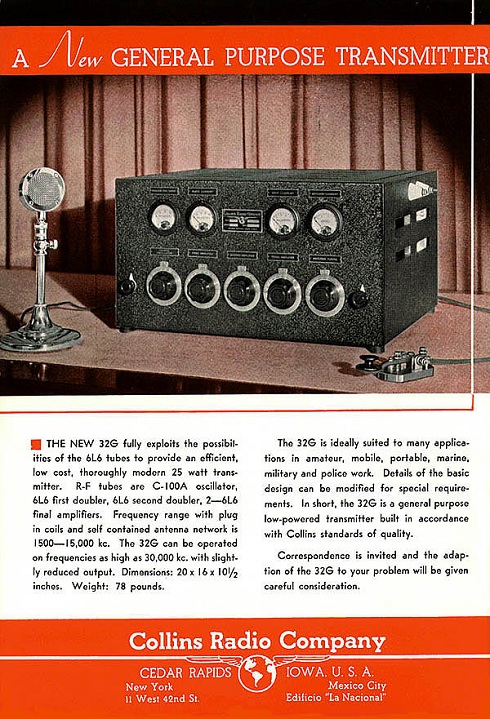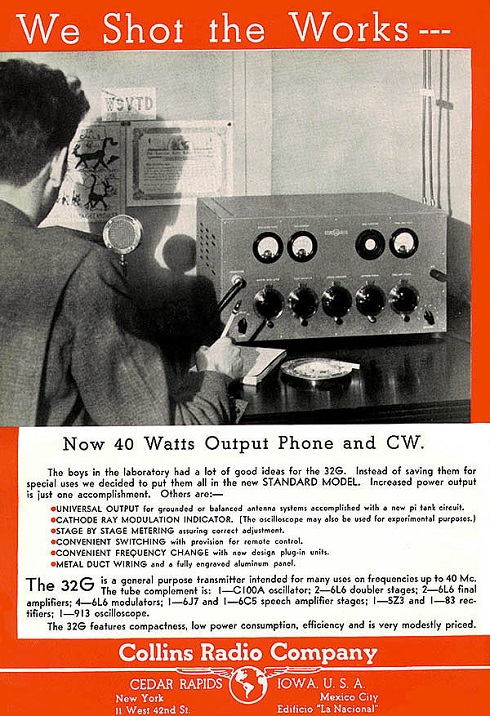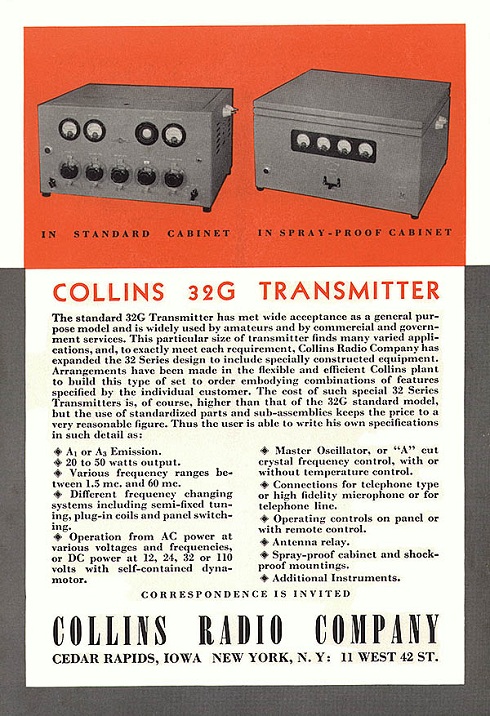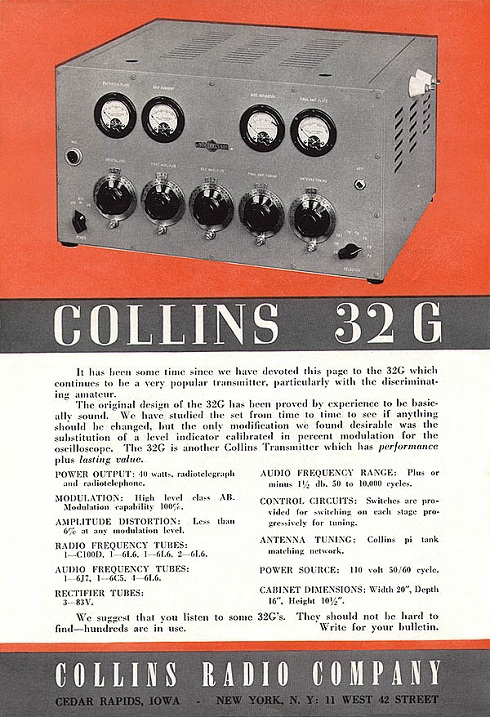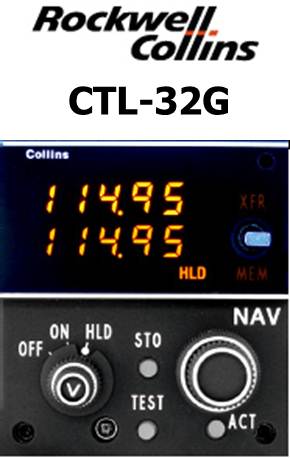32G Transmitter
Copyright CCA 2013
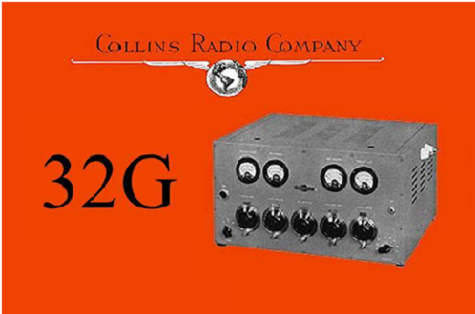
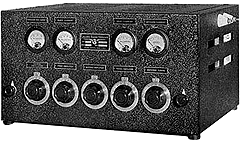 THE COLLINS 32G TRANSMITTER
THE COLLINS 32G TRANSMITTER
Introduced in September of 1936, the 32G was a celebration of the new 6L6 (it used eight initially) and was offered as a general purpose HF transmitter to both the amateur community and to commercial markets. Initially running 25 watts phone and cw, the rated output was later increased to 40 watts. The 32G covered the range of 1500 to 30,000 kHz using plug-in coils. Early production units used a Collins C-100D oscillator tube, while in later units another 6L6 was used as the oscillator. Two noteworthy features of the 32G included a cathode-ray oscilloscope modulation indicator introduced for a short period in mid-production units, and a universal antenna matching network using the new pi network. The oscilloscope modulation indicator was later replaced with a meter returning the 32G to its original metering configuration. One has only to look at the various pictures here to realize how many small (and some significant) variations there were during the lifetime of this transmitter. These variations involved metering, knob locks, placarding, internal tube complement and even general paint, feet and styling. The evolution of the thinking about styling and appearance during this time period at Collins is obvious. Logos moved around, paint evolved and knobs changed – in spades. It is a good guess that there was more miscellaneous variation in this 32G model during its production run than any other Collins model known. Production appears to have extended well into 1939, since they were promoting the popular rig as late as December,1938. Interestingly then, the 32G was the first model made by Collins Radio to wear two different Logos – starting with the Globe Emblem on the early models, running through the Transition Art Deco period, and then wearing the early Winged Emblem, as we know it now.
32G Variants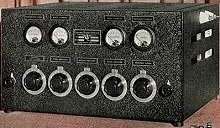
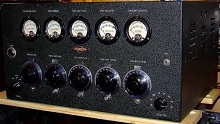
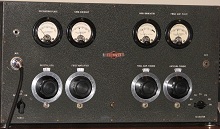

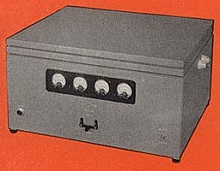
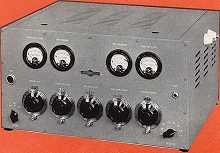 The desktop unit measured 20″W x 16″D x 10.5″ H and weighed 78 pounds. Modular subassemblies were used, allowing the flexibility to produce several variations, including versions with 12, 24, 32 or 110 volt DC and AC power supplies.
Specification Summary:
Power Output: 40 Watts, Radiotelegraph and Radiotelephone.
Modulation: High Level, Class AB, Modulation capability 100%.
Amplitude Distortion: Less than 6% at any modulation level.
Audio Frequency Range: Plus or minus 1 1/2 db, 50 to 10,000 cycles.
Control Circuits: Switches are provided for turning on each stage progressively for tuning.
Antenna Tuning: Collins pi tank matching network.
POWER SOURCE: 110 V 50/60 cycle.
Tube Complement: RF – Oscillator C100D (changing to a 6L6 or 6AG7), 1st, 2nd RF Amplifiers 6L6, Final PA (2 ea) 6L6, Audio 6J7 to 6C5 to (4 ea) 6L6 Modulator. HV Rectifier (2 ea) 83, LV Rectifier 5Z3 or 83, and Eye Tube 913 (When used)
For a full 32G Manual – CLICK HERE
Special Thanks need to be extended to Gary Halverson (K6GLH), Rod Perala (W5CZ) and John Firey (W5ZG) for their contributions to this 32G section of the Equipment of Collins Radio area of the website. Of note is the fact that one of these worthies has a currently operating ON_AIR position using the 32G almost every day. John Firey has gone so far as to accomplish the almost unheard of feat of earning his WAS ARRL Award using only Pre-1939 Collins equipment including using the beautifully displayed 32G operating position shown below.
The desktop unit measured 20″W x 16″D x 10.5″ H and weighed 78 pounds. Modular subassemblies were used, allowing the flexibility to produce several variations, including versions with 12, 24, 32 or 110 volt DC and AC power supplies.
Specification Summary:
Power Output: 40 Watts, Radiotelegraph and Radiotelephone.
Modulation: High Level, Class AB, Modulation capability 100%.
Amplitude Distortion: Less than 6% at any modulation level.
Audio Frequency Range: Plus or minus 1 1/2 db, 50 to 10,000 cycles.
Control Circuits: Switches are provided for turning on each stage progressively for tuning.
Antenna Tuning: Collins pi tank matching network.
POWER SOURCE: 110 V 50/60 cycle.
Tube Complement: RF – Oscillator C100D (changing to a 6L6 or 6AG7), 1st, 2nd RF Amplifiers 6L6, Final PA (2 ea) 6L6, Audio 6J7 to 6C5 to (4 ea) 6L6 Modulator. HV Rectifier (2 ea) 83, LV Rectifier 5Z3 or 83, and Eye Tube 913 (When used)
For a full 32G Manual – CLICK HERE
Special Thanks need to be extended to Gary Halverson (K6GLH), Rod Perala (W5CZ) and John Firey (W5ZG) for their contributions to this 32G section of the Equipment of Collins Radio area of the website. Of note is the fact that one of these worthies has a currently operating ON_AIR position using the 32G almost every day. John Firey has gone so far as to accomplish the almost unheard of feat of earning his WAS ARRL Award using only Pre-1939 Collins equipment including using the beautifully displayed 32G operating position shown below.
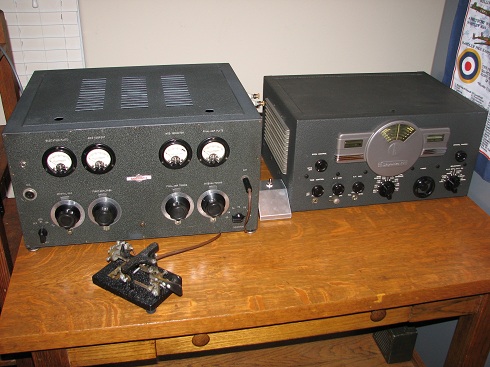 Vintage 32G Operating Position of John Firey, W5ZG, used to earn his WAS
The hallicrafters receiver in the photo is a very rare S22R Skyrider Marine
Detailed Photos of this 32G (later winged black wrinkle version)
Vintage 32G Operating Position of John Firey, W5ZG, used to earn his WAS
The hallicrafters receiver in the photo is a very rare S22R Skyrider Marine
Detailed Photos of this 32G (later winged black wrinkle version)
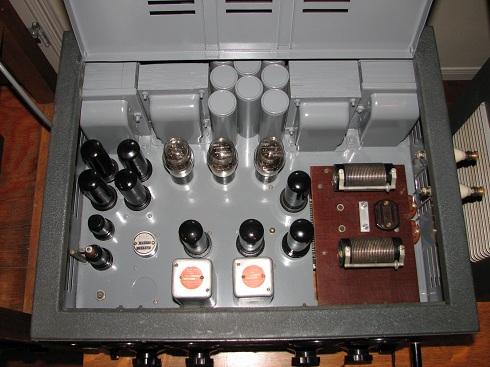 Vintage 32G with its lid open shows the remarkable restoration quality
Vintage 32G with its lid open shows the remarkable restoration quality
 Under Chassis view of this vintage 32G can be compared to the earlier one below, and significant construction differences are obvious.
Under Chassis view of this vintage 32G can be compared to the earlier one below, and significant construction differences are obvious.
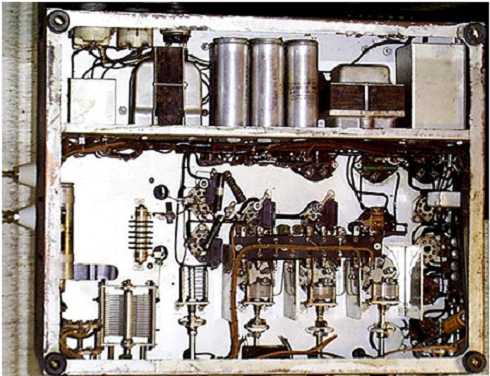 Bottom View 32G earlier version (5 main knob version)
Bottom View 32G earlier version (5 main knob version)
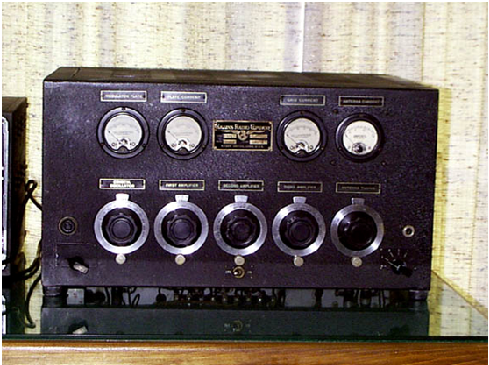 Front view of earlier Globe Emblem period of production (5 main knob version).
Front view of earlier Globe Emblem period of production (5 main knob version).
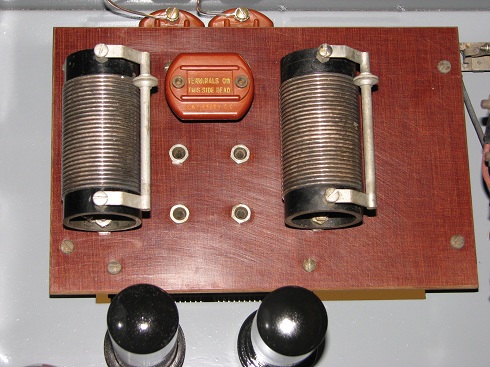 Tuning Roller Inductors in the later 32G shown in the operating position above.
Further perspective on the variations of the 32G throughout production can be gained by studying the 6 ads that Collins ran in QST between introduction in September of 1936 and their last promotion in December of 1938.
Tuning Roller Inductors in the later 32G shown in the operating position above.
Further perspective on the variations of the 32G throughout production can be gained by studying the 6 ads that Collins ran in QST between introduction in September of 1936 and their last promotion in December of 1938.
QST, September of 1936
QST, March of 1937
QST, May of 1937
The 32G production line shown is in one of the factory buildings behind the original 2920 First Avenue building. Collins had returned to this larger facility after a short period of manufacturing in the Laundry Building. The appearance of the 32G Line, although accurate from a physical standpoint, is a bit over-exaggerated from a line worker standpoint. As the story is told, Art Collins had rounded up every male employee in the company for this photo. In just a few short years, from 1933 to 1937, Collins had expanded their manufacturing from the original basement of their home, then to the First Avenue building basement, then to the Laundry Building and finally back to the manufacturing buildings behind the original 2929 First Avenue building where they still retained administrative offices. By 1939, they would be on the move again.
QST, July of 1937
QST, December of 1938 – Last 32G promotional ad in QST
The 32G had been in production almost 3 years and it was time to move on. The four-channel fixed-tuned 32RA (a commercial unit) was a direct descendent of the 32G. Interestingly, years later, the 32G nomenclature would again show up in the Rockwell Collins Avionics product line as part of the VIR-32 Navigation System – as the CTL-32G….A coincidence I am sure, since it violated the long used numbering system where the 30 series represented transmitters. It was good, however, to see that number again – reminding us of a great ancestor from over a half century earlier.
Interestingly, years later, the 32G nomenclature would again show up in the Rockwell Collins Avionics product line as part of the VIR-32 Navigation System – as the CTL-32G….A coincidence I am sure, since it violated the long used numbering system where the 30 series represented transmitters. It was good, however, to see that number again – reminding us of a great ancestor from over a half century earlier.
– – – – – – – – CCA – – – – – – – –
Note: The images and text used in these pages are copyright 2013 protected, are restored and written by the Collins Collectors Association or its representatives, and may not be used in any other commercial or website applications. They may be downloaded and used privately – not for publication or internet use.
- CCA COLLINS HISTORICAL ARCHIVES
- The Pre War Years
- 150 Series Transmitter
- 2A, 2B AND 2C TUNERS (ATU)
- 30FX Transmitter
- 30FXB Transmitter
- 30FXC Transmitter
- 30FXR Transmitter
- 30J Transmitter
- 30W Transmitter
- 32 A/B Transmitter
- 32F Transmitter
- 32G Transmitter
- 40A/B Transmitter
- 45A Transmitter
- 4A Transmitter
- Bulletin 100
- Bulletin 101
- Bulletin 105
- Bulletin 200
- Bulletin 200A
- The Lost Decade
- The War Years
- Post War Broadcast / Commercial
- The Black Boxes
- The Grey Boxes
- The “S” Word or Solid State
